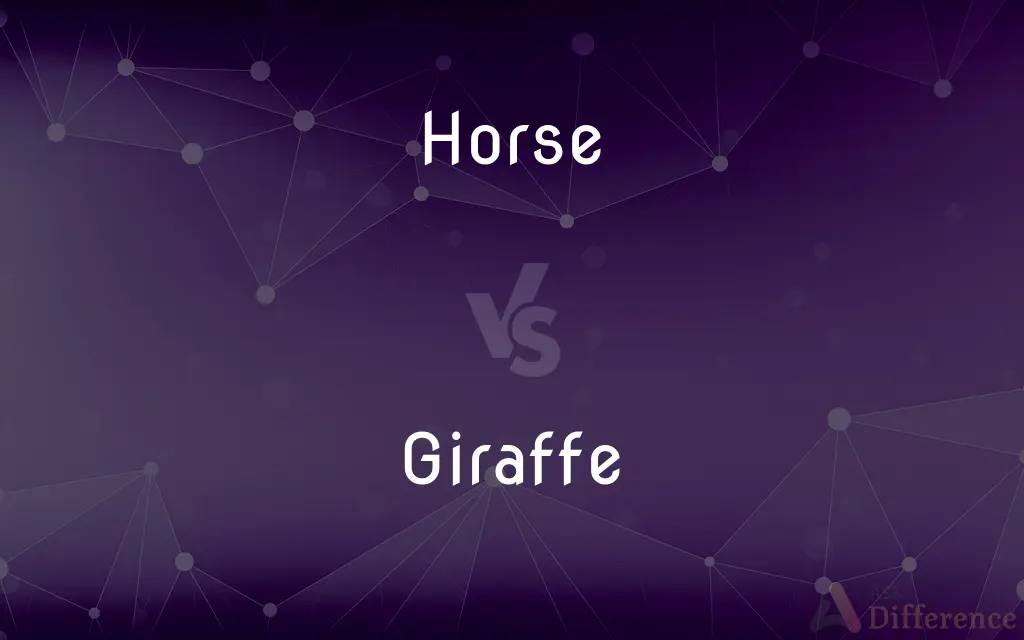Horse vs. Giraffe — What's the Difference?
By Tayyaba Rehman & Maham Liaqat — Updated on March 10, 2024
Horses are known for their speed and domestication, while giraffes are recognized for their long necks and height, highlighting nature's adaptation.

Difference Between Horse and Giraffe
Table of Contents
ADVERTISEMENT
Key Differences
Horses are renowned for their role in human history, being domesticated for transportation, agriculture, and sports. They are versatile animals, capable of running at high speeds, making them invaluable in various human activities. On the other hand, giraffes are the tallest land animals, adapted to reach high foliage in African savannas, which horses cannot access. This difference in physical adaptation illustrates their distinct ecological niches.
While horses have a strong social structure within their herds, which facilitates domestication, giraffes have a more casual social system, often forming temporary groups. This contrast in social behavior reflects the different survival strategies evolved by each species in response to their environments.
Horses have a diet primarily consisting of grass and grains, tailored to their digestive system, which is efficient in processing roughage. Giraffes, whereas, have adapted to browse on the leaves of trees, particularly acacia species, utilizing their long necks and tongues to reach their food.
In terms of lifespan, horses typically live up to 25-30 years when well cared for in domestic settings. Giraffes, on the other hand, have a slightly shorter lifespan in the wild, often living up to 20-25 years, influenced by the challenges of their natural habitat.
Horses have been selectively bred by humans for thousands of years, resulting in a wide variety of breeds with specialized abilities, such as racing, work, or companionship. Giraffes, whereas, have not been domesticated and exhibit less obvious physical variation, with different subspecies adapting to various parts of Africa.
ADVERTISEMENT
Comparison Chart
Height
Around 4.5 to 6 feet at the shoulders
Up to 18 feet tall, including the neck
Habitat
Domesticated globally, originally from steppes
African savannas and open woodland
Diet
Herbivorous, primarily grass and grains
Herbivorous, primarily leaves from trees
Social Structure
Herds with strong social bonds
Loose groups, less defined social structure
Lifespan
25-30 years (domesticated)
20-25 years (wild)
Compare with Definitions
Horse
Versatile in Use.
Horses have been used for riding, work, and companionship.
Giraffe
Tallest Land Animal.
The giraffe stretched its long neck to reach leaves high in the tree.
Horse
Domesticated Equine.
The horse galloped across the field, showcasing its speed and grace.
Giraffe
Unique Spot Patterns.
Each giraffe has a unique pattern of spots that distinguishes it from others.
Horse
Selective Breeding.
Selective breeding has produced various horse breeds, each with unique characteristics.
Giraffe
Leaf Browser.
The giraffe browsed on acacia leaves, using its long tongue to avoid thorns.
Horse
Social Animal.
The horses formed a close-knit herd, displaying their social nature.
Giraffe
Non-Domesticated.
Giraffes roam freely in the wild, with no domesticated populations.
Horse
Herbivore.
The horse grazed on the lush, green grass in the pasture.
Giraffe
African Native.
Giraffes are native to the savannas and open woodlands of Africa.
Horse
The horse (Equus ferus caballus) is a domesticated one-toed hoofed mammal. It belongs to the taxonomic family Equidae and is one of two extant subspecies of Equus ferus.
Giraffe
The giraffe (Giraffa) is an African artiodactyl mammal, the tallest living terrestrial animal and the largest ruminant. It is traditionally considered to be one species, Giraffa camelopardalis, with nine subspecies.
Horse
A large plant-eating domesticated mammal with solid hoofs and a flowing mane and tail, used for riding, racing, and to carry and pull loads.
Giraffe
A large African mammal with a very long neck and forelegs, having a coat patterned with brown patches separated by lighter lines. It is the tallest living animal.
Horse
A frame or structure on which something is mounted or supported, especially a sawhorse.
Giraffe
An African ruminant mammal (Giraffa camelopardalis) having a very long neck and legs, a tan coat with orange-brown to black blotches, and short horns. It is the tallest land animal, often reaching a height of 5 meters (16 feet).
Horse
A unit of horsepower
A 63-horse engine
Giraffe
A ruminant, of the genus Giraffa, of the African savannah with long legs and highly elongated neck, which make it the tallest living animal; yellow fur patterned with dark spots, often in the form of a network; and two or more short, skin-covered horns, so-called; strictly speaking the horn-like projections are ossicones.
Horse
Heroin.
Giraffe
A giraffe unicycle.
Horse
An obstruction in a vein.
Giraffe
(Cockney rhyming slang) A laugh.
Are you having a giraffe?!
Horse
Provide (a person or vehicle) with a horse or horses
Six men, horsed, masked, and armed
Giraffe
A very tall individual.
Horse
A large hoofed mammal (Equus caballus) having a short coat, a long mane, and a long tail, domesticated since ancient times and used for riding and for drawing or carrying loads.
Giraffe
An African ruminant (Giraffa camelopardalis formerly Camelopardalis giraffa) related to the deers and antelopes, but placed in a family (Giraffidae) by itself; the camelopard. It is the tallest of quadriped animals, being sometimes twenty feet from the hoofs to the top of the head. Its neck is very long, and its fore legs are much longer than its hind legs. There are three types, having different patterns of spots on the pelt and different territories: the Reticulated Giraffe, the Masai Giraffe, and the Uganda Giraffe. Intermediate crosses are also observed.
Horse
Any of various equine mammals, such as the wild Asian species Przewalski's horse or certain extinct forms related ancestrally to the modern horse.
Giraffe
Tallest living quadruped; having a spotted coat and small horns and very long neck and legs; of savannahs of tropical Africa
Horse
A frame or device, usually with four legs, used for supporting or holding.
Horse
(Sports) A vaulting horse.
Horse
(Slang) Heroin.
Horse
Often horses Horsepower
A muscle car with 400 horses under the hood.
Horse
Mounted soldiers; cavalry
A squadron of horse.
Horse
A block of rock interrupting a vein and containing no minerals.
Horse
A large block of displaced rock that is caught along a fault.
Horse
To provide with a horse.
Horse
To haul or hoist energetically
"Things had changed little since the days of the pyramids, with building materials being horsed into place by muscle power" (Henry Allen).
Horse
To be in heat. Used of a mare.
Horse
Of or relating to a horse
A horse blanket.
Horse
Mounted on horses
Horse guards.
Horse
Drawn or operated by a horse.
Horse
Larger or cruder than others in the same category
Horse pills.
Horse
A hoofed mammal, Equus ferus caballus, often used throughout history for riding and draft work.
A cowboy's greatest friend is his horse.
Horse
Any member of the species Equus ferus, including the Przewalski's horse and the extinct Equus ferus ferus.
Horse
(zoology) Any current or extinct animal of the family Equidae, including zebras and asses.
These bone features, distinctive in the zebra, are actually present in all horses.
Horse
Cavalry soldiers (sometimes capitalized when referring to an official category).
We should place two units of horse and one of foot on this side of the field.
All the King's horses and all the King's men, couldn't put Humpty together again.
Horse
A component of certain games.
Horse
(slang) A large and sturdy person.
Every linebacker they have is a real horse.
Horse
(historical) A timber frame shaped like a horse, which soldiers were made to ride for punishment.
Horse
Equipment with legs.
Horse
In gymnastics, a piece of equipment with a body on two or four legs, approximately four feet high, sometimes (pommel horse) with two handles on top.
She's scored very highly with the parallel bars; let's see how she does with the horse.
Horse
A frame with legs, used to support something.
A clothes horse; a sawhorse
Horse
(nautical) Type of equipment.
Horse
A rope stretching along a yard, upon which men stand when reefing or furling the sails; footrope.
Horse
A breastband for a leadsman.
Horse
An iron bar for a sheet traveller to slide upon.
Horse
A jackstay.
Horse
(mining) A mass of earthy matter, or rock of the same character as the wall rock, occurring in the course of a vein, as of coal or ore; hence, to take horse (said of a vein) is to divide into branches for a distance.
Horse
(US) An informal variant of basketball in which players match shots made by their opponent(s), each miss adding a letter to the word "horse", with 5 misses spelling the whole word and eliminating a player, until only the winner is left. Also HORSE, H-O-R-S-E or H.O.R.S.E. (see H-O-R-S-E).
Horse
(uncountable) The flesh of a horse as an item of cuisine.
Horse
(prison slang) A prison guard who smuggles contraband in or out for prisoners.
Horse
A translation or other illegitimate aid in study or examination.
Horse
Horseplay; tomfoolery.
Horse
(slang) Heroin drug.
Horse
(intransitive) To frolic, to act mischievously. (Usually followed by "around".)
Horse
(transitive) To play mischievous pranks on.
Horse
(transitive) To provide with a horse; supply horses for.
Horse
(obsolete) To get on horseback.
Horse
To sit astride of; to bestride.
Horse
(of a male horse) To copulate with (a mare).
Horse
To take or carry on the back.
Horse
To place (someone) on the back of another person, or on a wooden horse, chair, etc., to be flogged or punished.
Horse
(by extension) To flog.
Horse
(transitive) To pull, haul, or move (something) with great effort, like a horse would.
Horse
(informal) To cram (food) quickly, indiscriminately or in great volume.
Horse
To urge at work tyrannically.
Horse
To charge for work before it is finished.
Horse
A hoofed quadruped of the genus Equus; especially, the domestic horse (Equus caballus), which was domesticated in Egypt and Asia at a very early period. It has six broad molars, on each side of each jaw, with six incisors, and two canine teeth, both above and below. The mares usually have the canine teeth rudimentary or wanting. The horse differs from the true asses, in having a long, flowing mane, and the tail bushy to the base. Unlike the asses it has callosities, or chestnuts, on all its legs. The horse excels in strength, speed, docility, courage, and nobleness of character, and is used for drawing, carrying, bearing a rider, and like purposes.
Horse
The male of the genus Equus, in distinction from the female or male; usually, a castrated male.
Horse
Mounted soldiery; cavalry; - used without the plural termination; as, a regiment of horse; - distinguished from foot.
The armies were appointed, consisting of twenty-five thousand horse and foot.
Horse
A frame with legs, used to support something; as, a clotheshorse, a sawhorse, etc.
Horse
A frame of timber, shaped like a horse, on which soldiers were made to ride for punishment.
Horse
Anything, actual or figurative, on which one rides as on a horse; a hobby.
Horse
A mass of earthy matter, or rock of the same character as the wall rock, occurring in the course of a vein, as of coal or ore; hence, to take horse - said of a vein - is to divide into branches for a distance.
Horse
A translation or other illegitimate aid in study or examination; - called also trot, pony, Dobbin.
Horse
Heroin.
Horse
Horsepower.
Horse
To provide with a horse, or with horses; to mount on, or as on, a horse.
Horse
To sit astride of; to bestride.
Horse
To mate with (a mare); - said of the male.
Horse
To take or carry on the back; as, the keeper, horsing a deer.
Horse
To place on the back of another, or on a wooden horse, etc., to be flogged; to subject to such punishment.
Horse
To get on horseback.
Horse
Solid-hoofed herbivorous quadruped domesticated since prehistoric times
Horse
A padded gymnastic apparatus on legs
Horse
Troops trained to fight on horseback;
500 horse led the attack
Horse
A framework for holding wood that is being sawed
Horse
A chessman in the shape of a horse's head; can move two squares horizontally and one vertically (or vice versa)
Horse
Provide with a horse or horses
Common Curiosities
What distinguishes a horse from a giraffe?
Horses are known for their domestication and speed, whereas giraffes are recognized for their height and long necks.
What is the primary diet of a horse?
Horses primarily eat grass and grains.
Are horses social animals?
Yes, horses are highly social animals that form close-knit herds.
How tall can a giraffe get?
Giraffes can reach up to 18 feet tall, including their neck.
What are the main uses of horses by humans?
Horses are used for transportation, sports, work, and companionship.
Do giraffes have predators?
Yes, giraffes' main predators include lions, hyenas, and leopards.
Why are horses important to humans?
Horses have played crucial roles in transportation, agriculture, and companionship throughout human history.
Can giraffes be domesticated like horses?
Giraffes have not been domesticated due to their specific habitat needs and social structure.
What type of social structure do giraffes have?
Giraffes have a loose social structure with temporary groups.
How do giraffes eat from tall trees?
Giraffes use their long necks and tongues to reach and eat leaves from tall trees.
How long do horses typically live?
Domesticated horses typically live 25-30 years.
What unique features do giraffes have?
Giraffes have long necks, tongues, and unique spot patterns.
Are there different breeds of giraffes?
There are several subspecies of giraffes, each adapted to different habitats within Africa.
Can giraffes move fast?
Giraffes can run at speeds up to 35 mph for short distances.
How have horses been bred by humans?
Humans have selectively bred horses for various purposes, resulting in diverse breeds.
Share Your Discovery

Previous Comparison
Taxation vs. Tax
Next Comparison
Marijuana vs. HydrochronicAuthor Spotlight
Written by
Tayyaba RehmanTayyaba Rehman is a distinguished writer, currently serving as a primary contributor to askdifference.com. As a researcher in semantics and etymology, Tayyaba's passion for the complexity of languages and their distinctions has found a perfect home on the platform. Tayyaba delves into the intricacies of language, distinguishing between commonly confused words and phrases, thereby providing clarity for readers worldwide.
Co-written by
Maham Liaqat












































